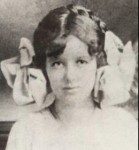 Mary Phagan was a young girl who lived in Atlanta, Georgia. A hundred years ago she was bludgeoned, raped and strangled to death five weeks before her fourteenth birthday in 1913. Leo Frank, a jew from New York who was the superintendent of the National Pencil Company, was indicted and tried the crime. Though Frank was convicted, the governor of Georgia commuted Frank’s sentence to life in prison. A little less than two months later 25 men, who called themselves “Knights of Mary Phagan”, took Frank from the state penitentiary to Marietta and with a rope hung him by his neck from a tree. (This overview is derived, with some additions, from Little Secrets – The murder of Mary Phagan and the death of Leo Frank.)
Mary Phagan was a young girl who lived in Atlanta, Georgia. A hundred years ago she was bludgeoned, raped and strangled to death five weeks before her fourteenth birthday in 1913. Leo Frank, a jew from New York who was the superintendent of the National Pencil Company, was indicted and tried the crime. Though Frank was convicted, the governor of Georgia commuted Frank’s sentence to life in prison. A little less than two months later 25 men, who called themselves “Knights of Mary Phagan”, took Frank from the state penitentiary to Marietta and with a rope hung him by his neck from a tree. (This overview is derived, with some additions, from Little Secrets – The murder of Mary Phagan and the death of Leo Frank.)
At the time the Frank prosecution was called “the trial of the century”, but Whites today, including myself, are woefully ignorant of what it was all about.
In this podcast and the brief series which follows I’ll examine the context and ongoing reverberations of this historic murder, trial and lynching, with a particular focus on what this reveals about relations between Whites, jews and blacks – then and now.
The “Little Secrets” article concludes with an interesting, but probably little-known link between the Phagan murder and the rebirth of the Klan in 1915.
A few months after the Frank lynching, on Thanksgiving evening, some of the Knights of Mary Phagan, along with a number of other men (34 in all) burned a cross and read from the bible atop Stone Mountain, east of Atlanta, and declared the founding of the Knights of the Ku Klux Klan.
The Birth of a Nation, first screened in 1915, is most often credited with this rebirth. The Wikipedia article describes it with the usual jewish distortion, twisting history to fit their anti-White narrative:
The film was a commercial success, but was highly controversial owing to its portrayal of African-American men (played by white actors in blackface) as unintelligent and sexually aggressive towards white women, and the portrayal of the Ku Klux Klan (whose original founding is dramatized) as a heroic force.
The film is also credited as one of the events that inspired the formation of the “second era” Ku Klux Klan at Stone Mountain, Georgia, in the same year. The Birth of a Nation was used as a recruiting tool for the KKK.[9] Under Democratic President Woodrow Wilson, it was the first motion picture to be shown at the White House.
Without accounting for the jews it is not possible to understand how in the course of the past hundred years the United States went from having a White man, proud of his race, in the White House, to the mulatto-in-chief who occupies it today.
Yet many accounts of such significant events, including the “Little Secrets” account of the Phagan murder cited here, do indeed omit any mention of the jews. The article begins by noting:
To some it is the “Murder of Mary Phagan.” Others call it “The Trial of Leo Frank.”
From the point of view of the jews, thanks to whose influence in academia and corporate media in the intervening century has now come to dominate even in non-jew minds, the entire incident revolves around Leo Frank and his jewishness. In jew-centric narratives the murder of Mary Phagan is downplayed, or even forgotten. The emphasis on Frank is evident in titles like “The Leo Frank Trial/Lynching/Affair/Travesty”. The moral of such narratives is that the jew has been wrongly accused, convicted and lynched – with Frank, and the jews in general, representing the real victims.
A good example of the jewish point of view, how Frank fits into the larger jewish narrative of their history amongst Europeans, is provided by David Turner in an article in his blog “Antisemitism and Jewish Survival”, hosted by the the Jerusalem Post. An American lynching: the Leo Max Frank Affair.
David Turner was the first director of the organization Justice for the Pollards; he created Jews United to Defend the Auschwitz Cemetery
Introduction: The trial and murder of Leo Frank stands in stark contrast to the outcomes of those other contemporaneous antisemitic outrages, the “trials” of Menahem Beilis and Alfred Dreyfus. In the end Russia and France, however reluctantly, recanted and their victims survived. Not so the American Jew. This incident illustrates the depth of antisemitism present in the United States for decades preceding the First World War, a level that only intensified after that war, and continued to do so through the Second World War and beyond. It was this same antipathy towards Jews, endemic to Western culture, that resulted in America violating its long tradition of refuge as last resort, at least when it came to Europe’s Jews fleeing the Holocaust.
The podcast will be broadcast and available for download on Tuesday at 9PM ET.
Podcast: Play in new window | Download









